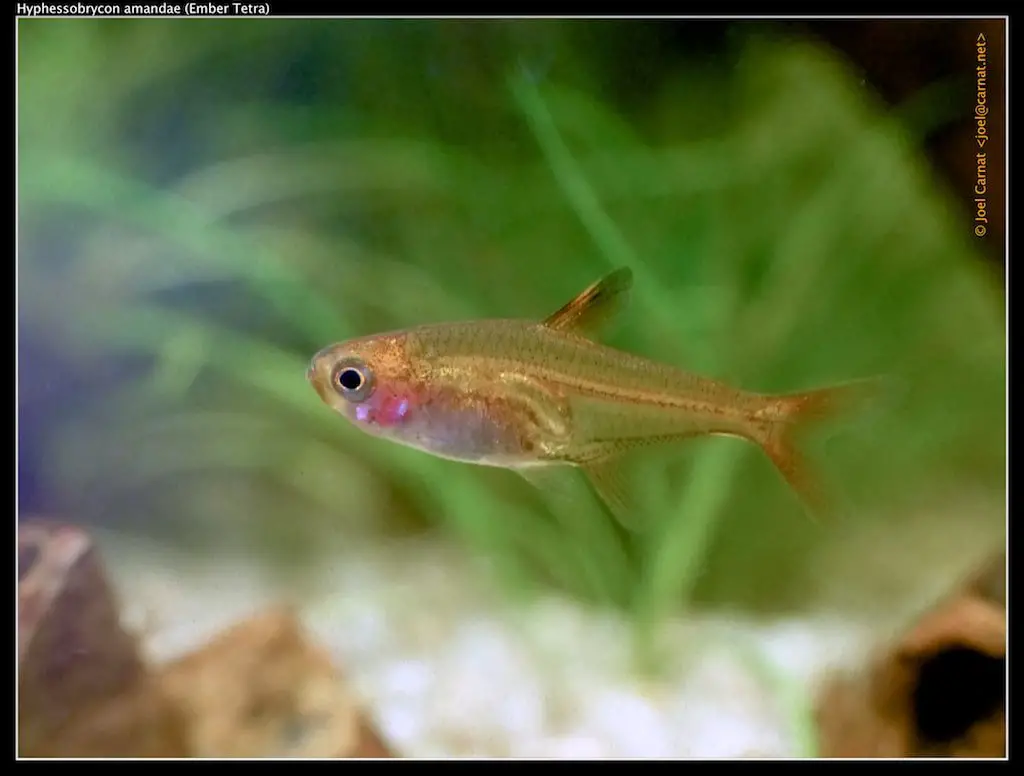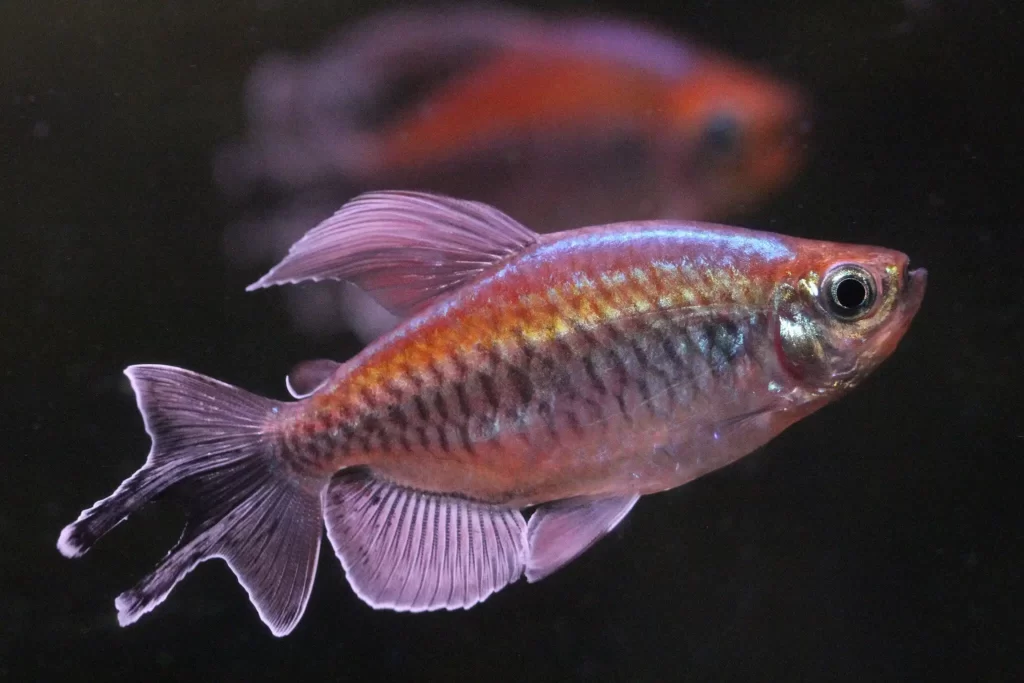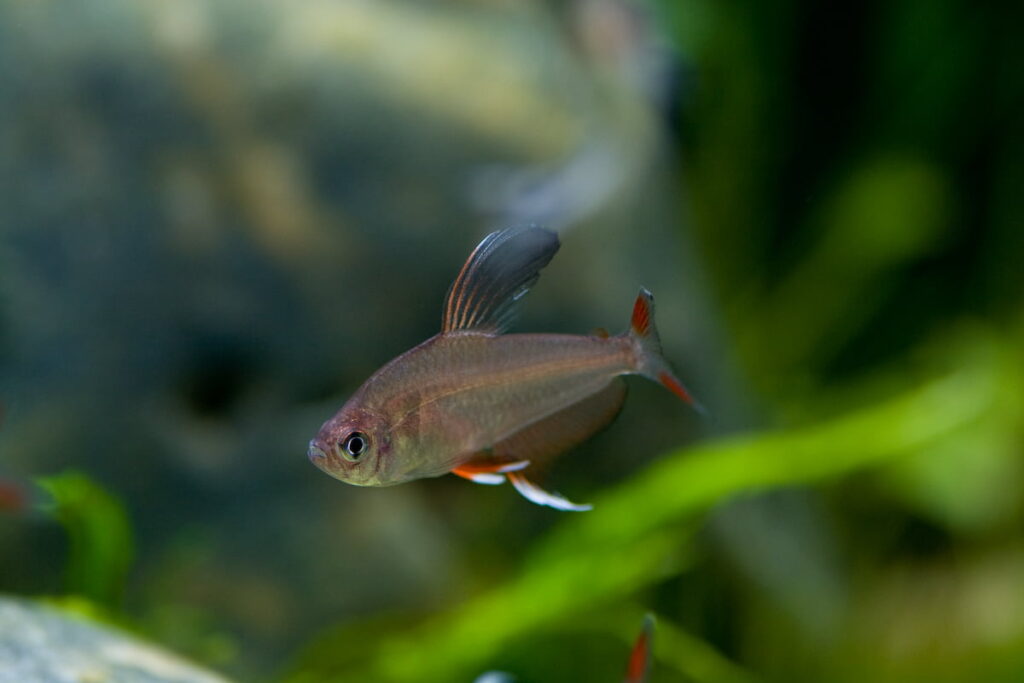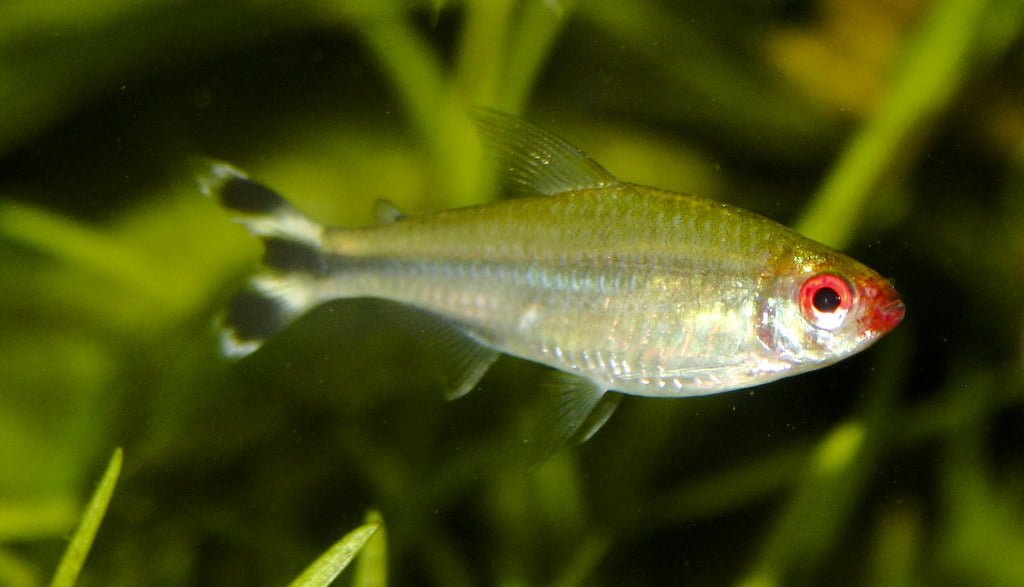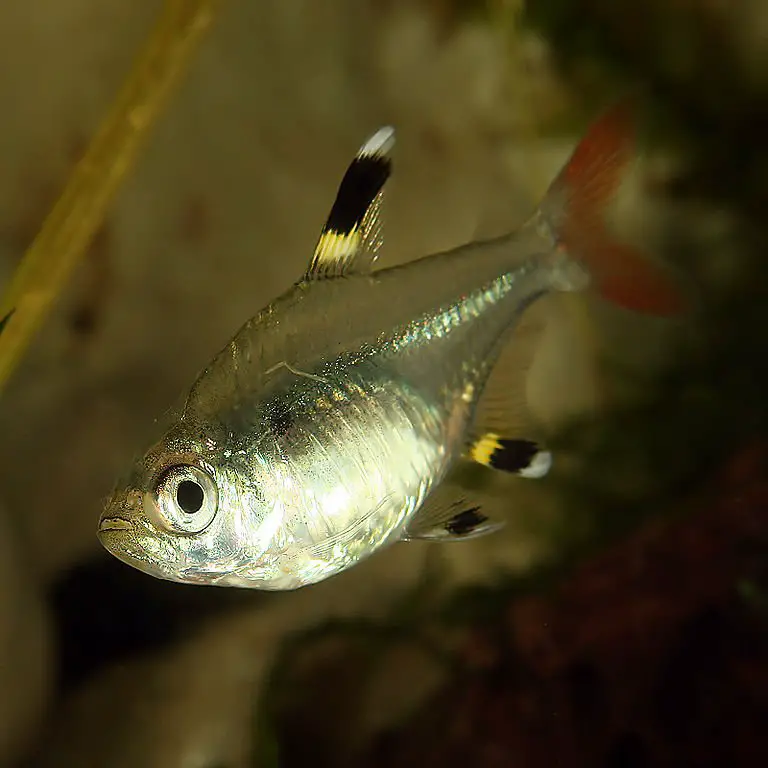Ember tetras are one of my favorite fish in the hobby. I fell in love with them at first sight. This is a long-ago story. They caught my eye from a distance. To me, at first, they looked like fire swimming in water. I wanted to buy them at sight, but I hadn’t done research about them, so I didn’t take them with me. I returned home and googled them and found out that ember tetras are specially kept in a planted aquarium. In a normal aquarium, their color fades away.
At that time, I wasn’t into aquascaping, and I didn’t know how to aquascape. It was heartbreaking at that moment, but I didn’t give up. The more pictures of ember tetra I look, the more I wanted it. So, at that moment, I decided to learn to learn to grow plants in the aquarium. I started with beginner plants, learned the ways of lighting, providing CO2, fertilization, etc. and when I finally could keep plants without dying, the first thing I bought was ember tetras.
When I kept my ember tetras in my planted aquarium, WOW! They looked amazing. I couldn’t keep my eyes off them. Later I added neon tetras, and the combination of neon tetras and ember tetras was amazing. Neon tetras give iridescent neon blue color, and ember tetras give blazing fire colors. This combination made take so much better.
One thing to note about ember tetras is, they are shy fish. Most of the time, you won’t see all of your ember tetras in the tank. They will be most of the time hiding. So provide lots of hiding places. This is also the reason I added neon tetras instead of cardinal tetras. Cardinal tetras are much larger than ember tetras, and I didn’t want my ember tetras to feel threatened or stressed.
To me, neon tetras, galaxy danio, and cherry shrimps are the best combination to ember tetras.
Introduction of Ember Tetra
Ember Tetra (Hyphessobrycon amandae) are shy shoaling fish that loves planted aquarium. They bring out their best color when they are kept in a planted aquarium. They are small size fish, so they are suitable for nano tanks as well. I wouldn’t recommend them for beginners. They are peaceful fish and can be kept with a variety of similar-sized fish.
Classification
Kingdom: Animalia
Phylum: Chordata
Class: Actinopterygii
Order: Characifomes
Family: Characidae
Genus: Hyphessobrycon
Species: H. amandae
Origin and Habitat
Ember tetras are South American fish. They are found in the Araguaia river of Brazil. They are mostly found in the small, shaded, planted region of the river where there is a slow water movement.
Description of Ember Tetra
Ember tetras have one of the most beautiful colors in the hobby. They have an amber-colored body. We are so used to seeing patterns in our fish, but ember tetras don’t have any patterns. Their whole body is ember-colored with a translucent body at the posterior side. Few black marks, red colors can be seen at the end of the dorsal fin. Except for the eyes and tip of the dorsal fin, the whole body is vibrant ember color. It has a vibrant orange color.
Ember tetras tend to get paler when they are stressed or unhappy. It could be because of tank setup, food, or tank mates. I will talk more about this later in the article. One another factor for getting paler is the time of the day. From sunset to sunrise, they tend to have more faded colors. This is because, at those times, they are least active and could also be asleep.
Males and females can be separated based on their color as males are more vibrant, whereas females are slightly paler. However, I would look at the body structure to differentiate sex.
They are very small fish. They grow up to 0.8in (2cm).
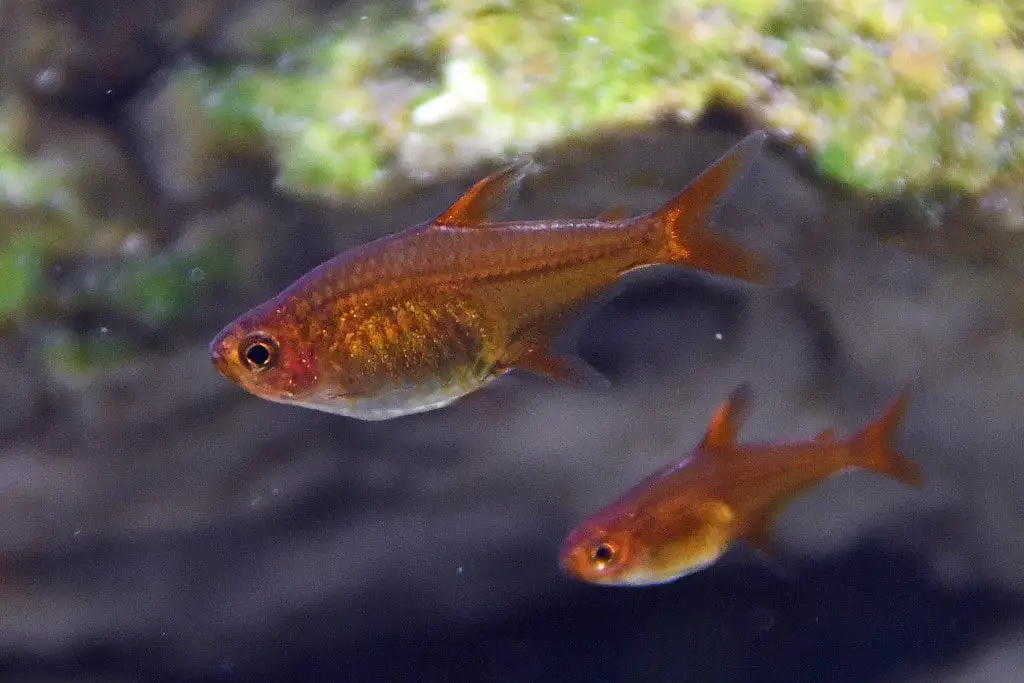
Numbers of Fish
Ember tetras are shoaling fish, and they do best when they are kept in groups. Because of their shy nature, they always rely on their group for protection. A small group of 6 will be the bare minimum for them. You can always get more based on your tank size, but for a 15-gallon tank, 6 of these tetras will be the best number.
Lifespan
For a fish that grows only 2cm, they can live for a long time. They have a lifespan of 5-10 years. Keeping for that long would require lots of care, so give them all the right nutritional food and do your water change.
Sex Differences
Just like any other fish, you can differentiate ember tetras based on their body structure. Although they can be separated based on color, the body structure is more reliable as like I said before, they can get paler when they are stressed.
Males are more slender, and females have a rounder body.
Fish Difficulty
Although ember tetras are hardy fish, they are not beginner fish. They need planted aquarium setup, their shy behavior can lead fish to stress, and you need to have an idea of schooling/shoaling fish. Ember tetras are happy when there are plants around. For a beginner who has no idea on how to set up a planted aquarium, many things can go wrong. From overuse to underuse of fertilization, picking the wrong substrate for plants, to wrong lighting, and many more. There are a lot of things to learn. Take your time, choose an easy plant, and learn to grow from there. When you learn to take care of your plants, then you can add fish in it. It’s a long process, and a lot of things to learn so ember tetras are only for experienced (with plants) keeper.
Water Condition in the Tank
Ember tetras are hardy fish. They can survive in most parameters, but they favor slightly acidic water had low hardness.
Temperature
They can live in a wide range of temperatures. From below as 73°F (23°C) to high as 84°F (29°C). I would keep them at 77°F (25°C)
pH
Most ember tetras are captive bred, so they have got used to neutral pH; however, they still love low pH levels. The 5.5-6.5pH level will be ideal for them.
Hardness
Due to captive breeding, they have got used to medium hardness water. They still prefer soft water of 5dGH, but you can go as high as 15dGH.
Aquarium Setup
Ember tetras are very planted aquarium demanding fish. Even in the wild, they live around plants and submerged trees. In the absence of plants, they get paler. You can keep them in the normal tank; however, the fish you bought and you are keeping will feel a lot of differences due to the absence of a vibrant amber color.
Ember tetras like to swim around plants. They use plants for hiding and breeding. They don’t have a specific plant selection. Anything from stem plants to moss will work for them. For plants, you can use Rotala, Ludwigia, Hornwort, Amazon Sword, Java Fern, java moss, etc. Add floating plants too. This will give them a sense of protection from high grounds. For floating plants, you can use duckweed. They will appreciate the love you give to your plants by showing you a vibrant ember color.
Either you do minimum planted aquarium or heavy planted aquarium, add plenty of hiding spots. They will need it.
Tank Size
Ember tetras are small fish. Due to this reason, they are heavily favored for nano tanks. They are great for nano tanks if you plan on keeping then in a very small number, i.e. 6. 15 gallons tank would work for six ember tetras. This is the basic minimum if you plan on changing the water every week. If you plan on getting 20 or more, get at least 20-25 gal tank (60-80 liters).
Water Type
Ember tetras can live in both blackwater and clear water. They usually prefer blackwater as in nature, they are found in tannin water. If you plan on converting planted aquarium to different water types, do check if your plant is compatible with change.
Filtration
In nature, ember tetras are found in slow-moving water. In the aquarium, get a slow current water flow filter. High speed can stress them out. Go for a sump or canister filter if you have a community tank. If the tank is just for your ember tetra, a Hang on Back filter or a sponge filter will do just fine.
Decoration
When I talk about decoration, I usually mean any decorations that provide hiding places for fish. It can be fake plants, and plastic made toys or pot. Anything is fine as long as they can provide a hiding place and won’t harm fish. Usually, artificial plants have spiky leaves that harm fish. In case of such spiky leaves, make it blunt by melting it or cutting that piece off. For plants, I would recommend getting real plants. Learn to grow plants!!!
Get a dark background as a dark background also brings out their best color.
Substrate
Ember tetra loves black, so a dark substrate is best for them. Use a substrate based on your plant selection. Ember tetras don’t care about what kind of substrate it is (because they don’t dwell at the bottom of the tank), as long as it is black in color.
Lighting
They don’t have a preference for lights, but you will need them for the plants. If you are going to have blackwater, a dim light would be great, but for a densely planted tank, you gonna need excellent aquarium light. Based on your tank size, you can get ADA lights. From https://www.adana.co.jp/en/contents/products/na_lighting/index.html, you can choose the size and type of lights you want.
Water change
Water change is to remove ammonia and nitrites. Ammonia and nitrite are toxic to fish. When they are in high concentration, fish get sick and die. Beneficial bacteria present in the aquarium convert ammonia to nitrite, and another species of bacteria convert nitrite to nitrate. Nitrate isn’t harmful to fish, and plants utilize nitrate for nitrogen. In a planted aquarium, the goal is to balance the nitrogen cycle so that you will not need to (large) water change.
Before water change, check your water parameters. Know your ammonia and nitrite level.
If your aquarium is densely planted and is balanced (ammonia, nitrite, and nitrate close to zero), then you will only be needing to change 20-25% water. If the ammonia or nitrite is high, that means the system isn’t balanced. Before it harms your fish, do a water change to dilute the concentration (50% water change).
For a nano tank, do at least 50% water change even if it is densely planted. Most people think water change for only ammonia and nitrite, but water change is to remove or induce the hormone of fish. In nano tanks, due to small space, a hormone present in water that isn’t maintained can bring an imbalance in the hormone.
Tank Mates
Ember tetras are shy shoaling fish. You can set a species tank with just them, and it will still love amazing, but if you want to spicy few things up, you can always add similar sized peaceful fish. Ember tetras mostly prefer tank mates that are slow swimmers. You can keep them with cardinal tetras, neon tetras, galaxy danio, guppies, drape fin barb, cherry barb, etc. Ember tetras don’t dwell at the bottom layer of the tank, so getting a bottom dweller would be an excellent addition to the tank. Ember tetra doesn’t harm shrimps, so getting contrast color shrimp will very much highlight the tank. Snails are also a great addition to the tank.
Since ember tetras are shy fish, don’t keep them with large (even if they are peaceful fish) with them. Large size can stress them out, and sometimes large fish might pickup on ember tetras.
Don’t keep them with semi-aggressive or aggressive fish.
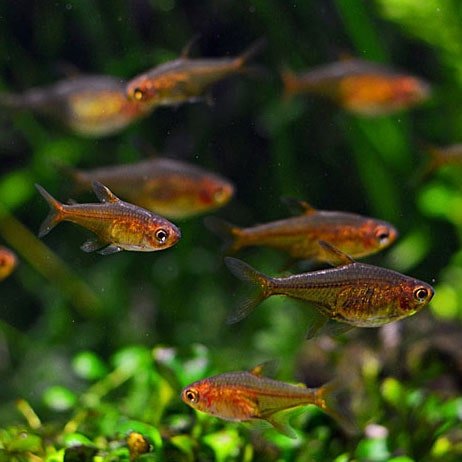
Ember Tetra Diet
Like any other tetras, ember tetras are very easy to feed. They eat anything that is given to them. As they are omnivores; for best health and color, live and frozen food such as bloodworm, or live foods such as brine shrimp and Daphnia, along with dried flakes.
Ember tetra is small fish, so you will need to break down the food into smaller pieces so they can eat. They can be fed once or twice a day. Feed only as much as they can eat within 1-2 minutes.
Proper high-quality food can bring their best color and improve their immunity to fight against diseases.
Breeding Ember Tetra
Ember tetra is not difficult to breed, but you will need to provide the right conditions. They are egg spawners and will eat the young ones if the parents are not separated. To breed, separate the breeding pair to the breeding tank. Select the fastest and brightest male and female. It’s better to select females that are over one year old. Get 2-3 males for several females.
Filter and Breeding Tank Condition
You will need to set a certain temperature, pH, and hardness to promote breeding. Set temperature to 78-84°F (26-29°C), pH to 5.5-6.0 pH, and hardness of 2-5dGH. Set dim lights with plenty of plants, both submerged and floating. You can use java moss for breeding. Make sure you have airstone (you can use a filter as well, but make sure it doesn’t have a high flow rate). Make sure you have a divider to separate the eggs and parents. All of this will promote breeding. When male and female is ready to breed, the male will chase females and spawn eggs around the plants.
Eggs and Fry
After 24-36 hours, the eggs will hatch, and after 4-5 days, you can see the fry. They are very small and hard to see. Within moments of the hatch, you don’t need to feed fry as they are still attached to the yolk sac. After 4-5 days of hatching, feed them infusoria (ciliates, euglenoids, protozoa, unicellular algae, and small invertebrates). After a month, try to feed them adult food by breaking them down into smaller pieces. If they reject adult foods, keep on feeding infusoria until they are able to eat adult food.
After 8-12 weeks, they will resemble their parents. After nine months, females will be able to lay eggs, but it is better only to allow her to spawn when she is a year older.
Diseases And Cure
Like all living organisms, fish also get sick. Like humans, fish also have immune systems. When the immune system starts to fail, fish start to get sick, and if it is not taken care of, ultimately, fish dies. Ember tetras need more care because of their shy nature.
Summary
Ember tetras are to be loved and need care. They are shy fish, so most of the time, they will be hiding. They have the best color in the aquarium hobby, and a planted tank fully utilizes this. These tetra fish are shoaling fish, so you will need to keep them in groups. Because of their small size, you can add them in nano tanks, just don’t overcrowd them. Keep them with similar sized peaceful fish and avoid large fast-swimming fish as this behavior can stress them out.
